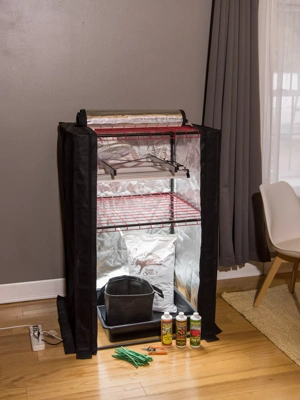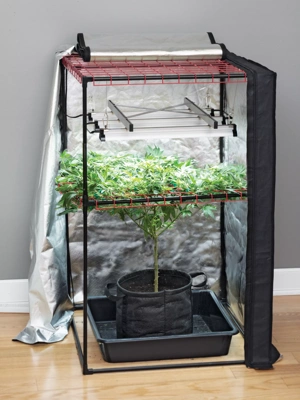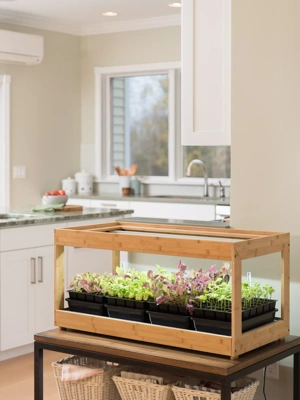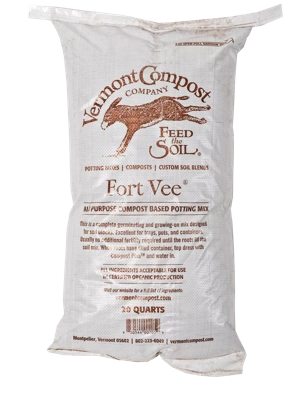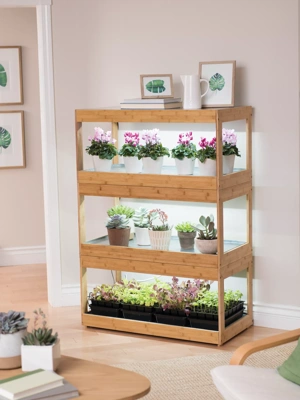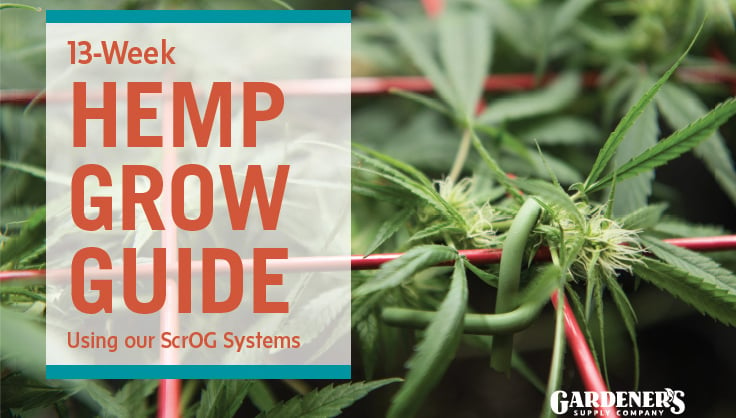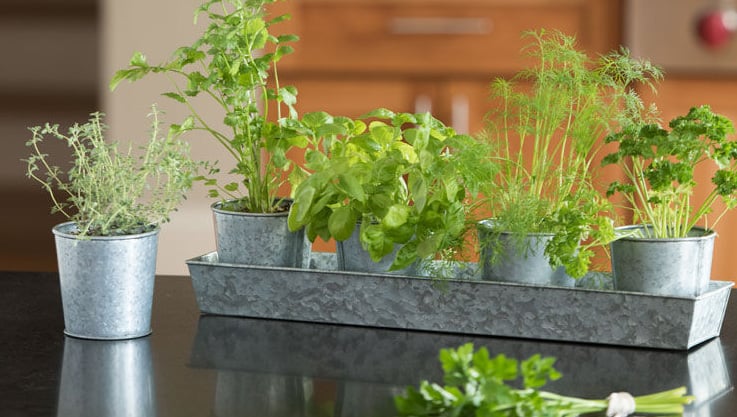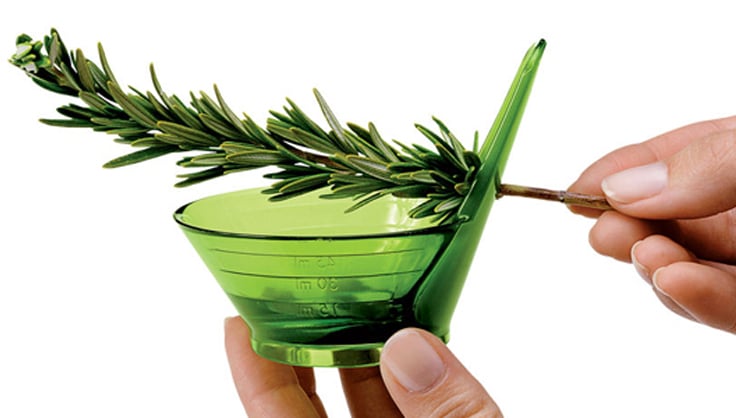Hemp Growing 101
A Beginner's Basics Guide to Growing Hemp Indoors
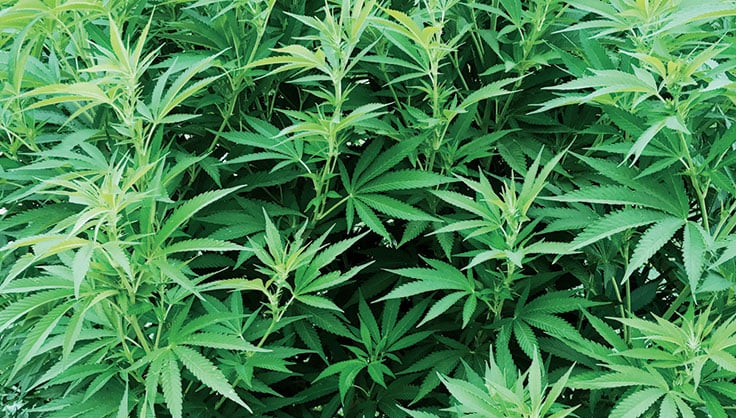 This healthy hemp plant is growing indoors under lights.
This healthy hemp plant is growing indoors under lights.Hemp is a fascinating plant, and renewable resource, and is used in a multitude of important and valuable commercial products. Hemp has been bred for thousands of years to express many different characteristics and uses. In modern times, we employ hemp for a variety of industrial purposes, such as making fibers, non-dairy milks, bioplastics, CBD (cannabidiol) extracts and products, just to name a few. Function aside, hemp plants are showy with fanciful foliage.
| In this article: |
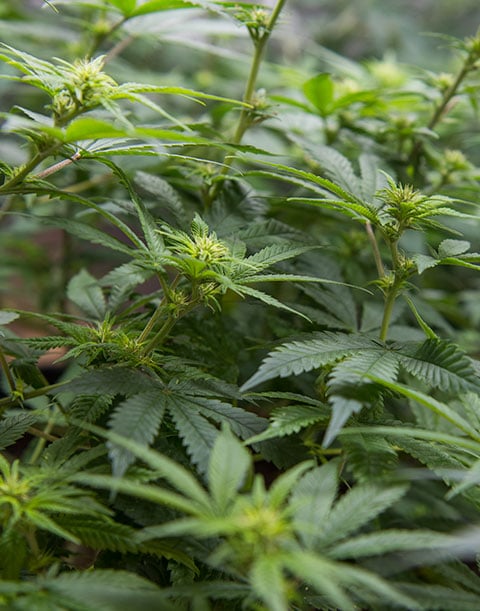 Buds forming on hemp plant.
Buds forming on hemp plant.What is Hemp?
Terminology surrounding hemp can be a little confusing. Today, botanists are in general agreement that there is only one species of Cannabis: Cannabis sativa.
Historically, however, two additional species were recognized: C. indica, and C. ruderalis. Both are now considered subspecies of C. sativa. There are also many cultivated varieties and hybrids. That said, you will still see them referenced as individual species, and described as having slightly different physical traits and chemical compositions. However, they all share DNA.
All cannabis plants contain the genes for producing both non-psychoactive CBD and psychoactive THC (tetrahydrocannabinol). The term psychoactive refers to substances that can affect a person's brain function or behavior.
Hemp vs. Marijuana
"Hemp" is classified, legally and commercially, as cannabis plants and products that contain less than 0.3 percent THC. Hemp growing is legal federally in all 50 states.
Any cannabis plant or product that has a higher than 0.3 percent THC content is classified as "marijuana" from both a legal and commercial standpoint. So it is important to know the THC levels in the species, variety, or hybrid you plan to grow.
Male vs. Female Hemp Plants: What is the Difference?
Cannabis species are dioecious: the male and female flowers grow on separate male and female plants. Many gardeners grow hemp from seed. When you germinate hemp seed approximately 50% of the plants will be female and 50% male. However, you can purchase "feminized" seed, which are produced by triggering female plants to produce pollen sacs with only female genetics for self- or cross-pollination. Feminized seed will produce only female plants. You can also propagate vegetative clones of your plant by taking plant cuttings.
- To harvest hemp flowers, you typically grow only female plants that remain unfertilized.
- Hemp fibers can be harvested from both male and female plants.
- Pollinated female plants produce seed (grain).
Any cannabis plant can spontaneously produce both male and female flowers. We call these plants hermaphrodites. Both the genetics of the plant and environmental stressors cause this phenomenon. To reduce this occurrence, make sure plants are well cared for and aren't subjected to environmental stress during flowering.
How Much Light Does a Hemp Plant Need?
Cannabis sativa is photoperiodic plant with vegetative and flowering phases that require different periods of darkness and daylight. Flowering in hemp plants is triggered when the dark period (night) is approximately 12 hours long. When the dark period is shorter than 12 hours, and the light period (daylength) is longer, plants remain vegetative and do not flower. Closed growing environments, such as a grow tent or blackout cover, allow you to control photoperiod. The subspecies of cannabis, C. ruderalis, or varieties and hybrids thereof, is day-neutral (also called auto-flowering) and will eventually flower even with shorter dark periods.
How to Grow Hemp Indoors
When you grow hemp plants indoors in a controlled environment under a grow light, it allows you to better manage plant growth and flowering. Hemp plants will have four different growing stages: germination, seedling, vegetative, and flowering.
How to Germinate Hemp Seeds
If you've grown tomato plants from seed, you'll grow hemp plants from seed using similar methods and environmental conditions:
- Pre-soak seeds for 8-12 hours to improve germination.
- Ideal seed germination temperature: Between 65-70 degrees F.
- Plant seeds 1-inch deep in moist Seed Starting Mix.
- Use a seedling Heat Mat and thermostat for soil temperature control.
- Use a humidity dome for the first to manage germination humidity.
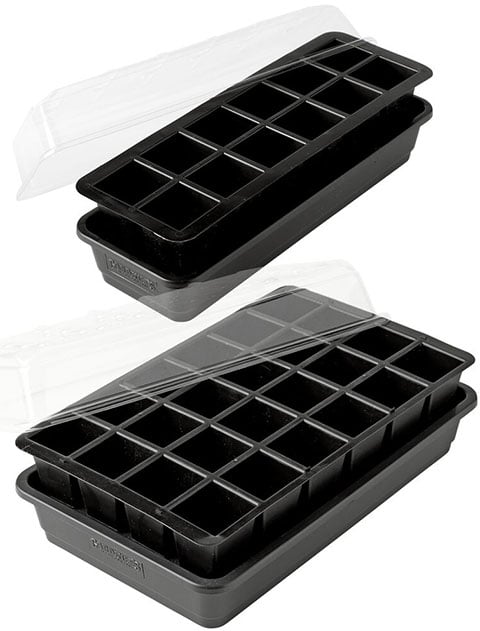 The self-watering GrowEase Seed Starter Kit has a clear dome that holds in humidity, aiding seed germination.
The self-watering GrowEase Seed Starter Kit has a clear dome that holds in humidity, aiding seed germination.How to Care for Hemp Seedlings
Temperature: Germinated seedlings need temperatures between 68-77 degrees F. You can continue using a heat mat to manage seedling temperature.
Relative humidity: Hemp seedlings perform best at a 65-70% humidity range. Keep the humidity dome over the seedlings for the first week or two to manage humidity levels.
Light volume: To deliver enough light once seeds germinate, use High-Output LEDs or High-Output T5 fluorescent grow lamps, placed several inches above the seedlings. When growing in the Hemp Grow Kit, set the seed tray in the base, then lower the adjustable high output LED fixture to the appropriate height for the seedlings.
Light photoperiod: Keep grow lights on 18-24 hours per day. If seedlings stretch, lower grow lamps closer to the plants and add time to their light cycle. Use a timer to automate the grow lamps.
Feed: Use a water-soluble, nitrogen-rich fertilizer with a target 3:1:2 NPK ratio at 1/4 the recommended application strength, to water or mist seedlings until transplanting. Different fertilizers will have slightly different NPK ratios; choose one that is similar in balance to the target ratio for each stage of development.
Transplanting: Once seedlings have rooted to the bottom and sides of the rooting cell or plug, transplant them into a 4- to 5-inch container using a transplant mix. Once hemp transplants have rooted to the bottom and sides of the 4- to 5-inch pots, transplant to a larger final container or fabric grow bag, using a slightly heavier compost-based potting mix.
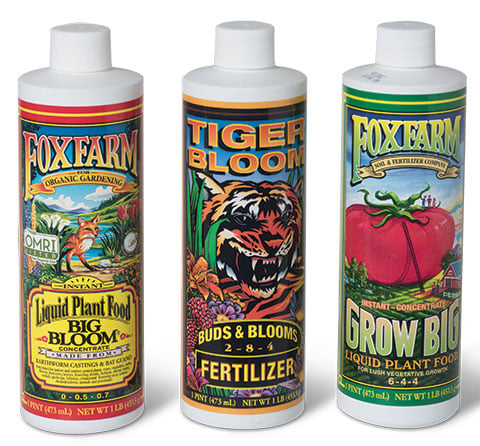 Trio of FoxFarm Fertlizers.
Trio of FoxFarm Fertlizers.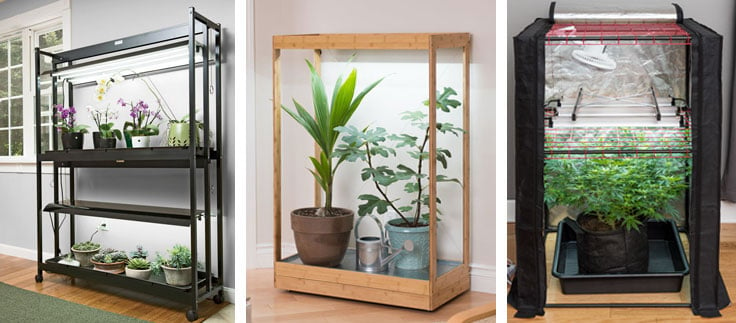 Super-bright LEDs are ideal for growing hemp and other light-loving plants. From left: LED SunLite High Intensity 2-Tier Garden, Tall Bamboo LED Grow Light Garden, and Hemp Success Kit
Super-bright LEDs are ideal for growing hemp and other light-loving plants. From left: LED SunLite High Intensity 2-Tier Garden, Tall Bamboo LED Grow Light Garden, and Hemp Success KitHow to Grow Vegetative Hemp Plants (Hemp Without Flowers)
Temperature: Hemp plants generally prefer semi-humid conditions at temperatures between 60-80 degrees F, depending on the age of the plant. Younger vegetative transplants perform better at temperatures between 70-82 degrees F.
Relative humidity: Vegetative transplants should be grown with humidity levels in the 40-70% range.
Light for vegetative growth: Keep grow lights on for 18-24 hours a day, which will keep plants in a vegetative (non-flowering) state and encourage more leafy growth. Adjust the lights upwards as plants grow taller.
Water: Hemp seedlings and vegetative transplants need their root zone consistently moist, but never soggy. A moist soil the wetness of a wrung-out sponge is a good target.
Feed: When plants are young and in a vegetative state, use a natural liquid, nitrogen-rich fertilizer with a target 3:1:2 NPK ratio. Feed weekly, as needed.

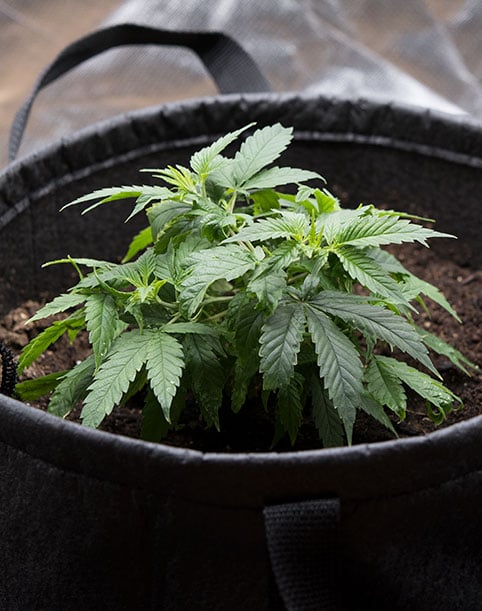 Hemp plant thriving in a Pop-Out Pot and larger plant transplanted into a Grow Bag. Hemp grows best in a loose and well-draining soil with an average pH of 6.0-7.0.
Hemp plant thriving in a Pop-Out Pot and larger plant transplanted into a Grow Bag. Hemp grows best in a loose and well-draining soil with an average pH of 6.0-7.0.How to Grow Flowering Hemp Plants
Temperature: Mature flowering plants need slightly cooler temperatures between 68-77 degrees F.
Relative humidity: When plants are flowering reduce humidity to the 40-50% range.
Air circulation: Keep the air moving to cut down on pests such as fungus gnats and leaf fungal diseases; as well circulate air warmed by grow lamps to cool plants. Use a small oscillating clip fan. If using a grow tent or blackout cover, venting it can also help you adjust temperature.
Light for flowering: After 30-60 days of vegetative growth, trigger plants to flower by changing the photoperiod. Set your grow lamp timer to 12 hours on/12 hours off, keeping the plant in complete darkness for 12 dark hours. If using a grow tent or blackout cover, keep it completely sealed during the dark/night period.
Water: Do not over-water plants when they are flowering. You can slightly reduce watering for mature plants, however, don't allow them to dry out regularly.
Feed: To support flowering, switch to a liquid fertilizer with a target NPK ratio of 1:3:4 that provides less nitrogen and more phosphorus and potassium. Feed weekly, as needed.
 Hemp plant with flower buds
Hemp plant with flower budsAs with any new plant project you undertake, successfully growing hemp will take some trial and error. Try experimenting with a small number of plants on your first try and follow these basic beginner steps.
Last updated: 03/29/2024
Print this Article:
Related items
Related Articles
Get the Dirt
Stay up to date on new articles and advice. Please fill out the information below.

